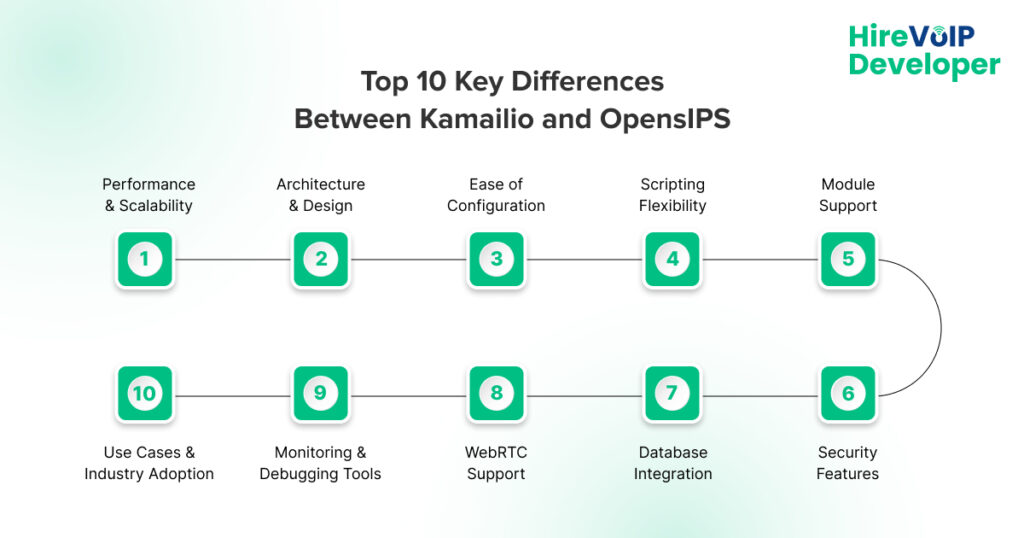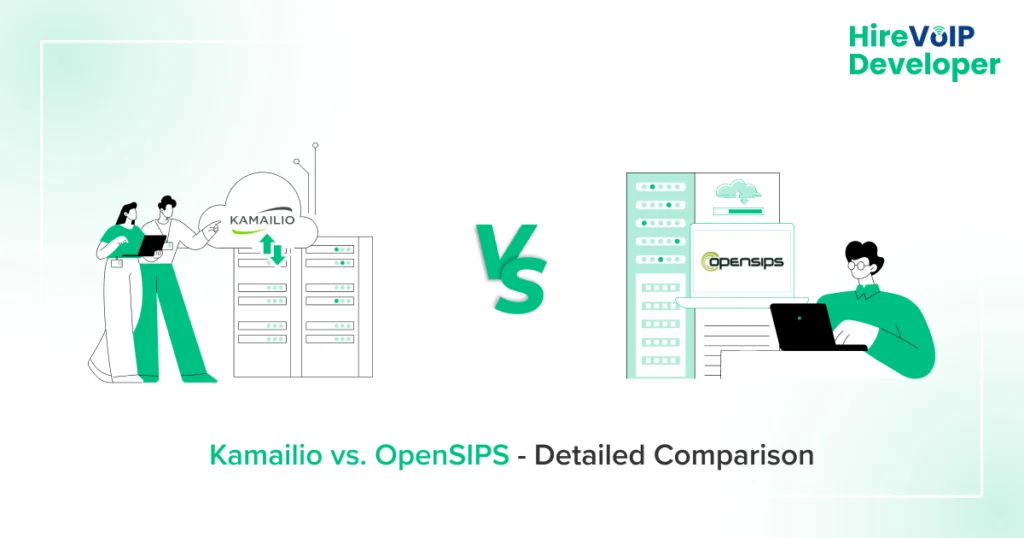📝 Blog Summary
This blog offers a comprehensive comparison of Kamailio and OpenSIPS across various parameters, including performance, architecture, and use cases. It helps businesses select the right SIP server tailored to their specific needs.
“The art of communication is the language of leadership.”
– James Humes
In the world of VoIP and real-time communication, how you route, manage, and secure calls can either strengthen your business or hinder its growth. That’s why understanding the difference between Kamailio and OpenSIPS isn’t just a technical curiosity; it’s a strategic decision. Both are powerful open-source SIP servers, but selecting the right one can significantly impact the performance, scalability, and flexibility of your entire VoIP communication infrastructure.
In this blog, we’ll explore OpenSIPS vs Kamailio in depth and help you understand which one might be the better fit for your needs.
But first, let’s take a look at Kamailio and OpenSIPS.
What is Kamailio?
Kamailio is a robust, open-source SIP server renowned for its high performance, scalability, and flexibility. Designed to handle thousands of calls per second, Kamailio is often used by telecom operators, ISPs, and large enterprises. It supports a wide range of features, including NAT traversal, load balancing, least-cost routing, and WebRTC, making it suitable for you to elevate your VoIP network with Kamilio.
Kamailio uses an asynchronous, event-driven processing model that enables it to scale exceptionally well on multi-core systems. It also boasts an active development community and extensive module support. Whether you’re looking to set up a SIP proxy, registrar, or a complex VoIP routing engine, Kamailio delivers the tools and power to make it happen.
What is OpenSIPS?
OpenSIPS, like Kamailio, is a high-performance open-source SIP server designed for building complex and scalable VoIP solutions. It evolved from the same codebase as Kamailio, but over time, the two projects have diverged in terms of architecture, feature set, and community focus.
OpenSIPS is recognized for its strong focus on modularity, multi-threaded performance, and a rich feature set that includes presence, IMS extensions, fraud detection, and advanced call control. It’s a preferred choice for building SIP load balancers, SBCs, and even B2BUAs. Many developers prefer OpenSIPS for its intuitive configuration and comprehensive management tools, making it a smart move to hire OpenSIPS developer when building a robust VoIP infrastructure.
Before we dive into the Kamailiovs.s OpenSIPS comparison, it’s essential to note that both platforms have undergone significant development and maturity.
Did You Know❓
Kamailio and OpenSIPS split from SER in 2008, like SIP-savvy siblings going their separate ways to rule different kingdoms.
🤔 Still debating Kamailio vs. OpenSIPS? We’ll help you decide.
Top 10 Key Differences Between Kamailio and OpensIPS
When choosing the right SIP server for VoIP infrastructure between OpenSIPs and Kamailio, understanding how each platform performs under various conditions is crucial. Kamailio and OpenSIPS may seem similar at first glance, but their differences become clear when compared across specific technical and operational parameters.
Below, we break down the key areas where they diverge and where they align, so you can make an informed decision based on your unique business needs.
So, let’s take a detailed look at how they compare across various parameters.

1. Performance & Scalability
When it comes to performance and scalability, both Kamailio and OpenSIPS are excellent, but they take different approaches. Kamailio follows an asynchronous, event-driven architecture, which enables it to handle massive amounts of traffic with minimal memory usage. This makes it ideal for scenarios requiring extreme scalability.
On the other hand, OpenSIPS uses a multi-threaded architecture. While it may consume more resources, it provides better control over parallel processing and can be more efficient under certain workloads. In the context of OpenSIPS vs. Kamailio performance, the choice ultimately depends on your traffic patterns and scaling requirements.
2. Architecture & Design
Let’s discuss OpenSIPS vs. Kamailio architecture. Kamailio’s architecture is non-blocking and event-driven, which makes it a great fit for large-scale, high-concurrency deployments. It can run on minimal resources while handling tens of thousands of calls.
OpenSIPS, by contrast, uses a process-based model where each worker handles a specific set of tasks. This makes debugging and scaling slightly easier for some developers. If you’re looking to compare Kamailio and OpenSIPS from an architectural standpoint, think of Kamailio as lightweight and reactive, while OpenSIPS is modular and parallelized.
3. Ease of Configuration
OpenSIPS generally wins points for ease of configuration. Its scripting language is perceived as slightly more intuitive, and its management tools, such as the OpenSIPS Control Panel, make real-time administration smoother. Kamailio’s configuration is powerful but may have a steeper learning curve for beginners.
Did You Know❓
More than 75% of OpenSIPS users choose it for flexible call routing and real-time control. If Kamailio’s the sprinter, OpenSIPS is the chess grandmaster.
4. Module Support
In terms of module support, both platforms are rich and continuously evolving. However, Kamailio has a slight edge in the number of supported modules, including advanced IMS, presence, and anti-fraud modules. Still, OpenSIPS is no slouch; its modules are often more tightly integrated and optimized for specific functions.
5. Scripting Flexibility
OpenSIPS provides a more readable scripting syntax, which many developers find easier to work with. Kamailio’s scripting is highly flexible but requires more familiarity. When weighing OpenSIPS vs Kamailio for custom call logic or routing scenarios, scripting comfort can be a deciding factor.
6. Security Features
Both Kamailio and OpenSIPS offer solid security tools, TLS, SRTP, IP blacklisting, and rate limiting are supported on both platforms. OpenSIPS has built-in anti-fraud modules, while Kamailio often relies on external integration for similar functions.
7. Database Integration
Both SIP servers support a wide range of databases, including MySQL, PostgreSQL, Redis, and more. Kamailio tends to lean on caching for performance, while OpenSIPS offers more dynamic DB interaction. If real-time database access is crucial, OpenSIPS might offer more flexibility.
8. WebRTC Support
Kamailio and OpenSIPS both support WebRTC, including DTLS and SRTP. The configuration may differ slightly, but neither has a clear upper hand. The difference between Kamailio and OpenSIPS in WebRTC comes down to personal preference in configuration style.
Did You Know❓
Over 90% of carriers chose Kamailio for its exceptional scalability, which easily handles over 80,000 active calls without causing any performance issues.
9. Monitoring & Debugging Tools
OpenSIPS offers native tools, such as the OpenSIPS Control Panel, for real-time monitoring, which can be a significant advantage. Kamailio supports similar tools, such as Siremis, but may require more setup. For developers who like visual interfaces, OpenSIPS often feels more user-friendly.
10. Use Cases & Industry Adoption
Kamailio is widely adopted by large-scale providers and telecom carriers due to its scalability and lightweight design. OpenSIPS is popular among hosted VoIP providers and enterprises needing fine-grained control and fraud prevention.
In OpenSIPS vs Kamailio for load balancing, OpenSIPS is often praised for its straightforward configuration and real-time routing control.
What to Consider When Choosing Between Kamailio and OpenSIPS?
Choosing between Kamailio and OpenSIPS isn’t always a clear-cut decision. Both have matured to a point where either can serve as the foundation of a rock-solid VoIP infrastructure. But here’s what to consider:
OpenSIPS vs. Kamailio: Performance matters most when scaling is your top priority. If configuration simplicity and visual tools are important, OpenSIPS may feel more accessible. However, if you require a lightweight, ultra-performant core for handling millions of transactions, it might be time to hire Kamailio developers to build a solution optimized for speed and efficiency.
Did You Know❓
1 Setup, 2 Powers: Kamailio + OpenSIPS
Over 40% of large VoIP deployments now utilize both tools together: Kamailio for edge proxying and OpenSIPS for smart routing. SIP Avengers, assemble!
🔧 Kamailio or OpenSIPS? Let’s build your VoIP system right.
Wrapping Up
The increasing demand for scalable, real-time communication platforms has pushed more providers to adopt open-source SIP servers. Whether it’s about cost-efficiency, flexibility, or speed, solutions like Kamailio and OpenSIPS are taking center stage in the VoIP ecosystem.
Things to Keep in Mind:
- Traffic Load: Choose Kamailio for ultra-high concurrency, OpenSIPS for parallel processing.
- Team Skillset: OpenSIPS is often easier for beginners, while Kamailio suits experienced developers.
- Use Case Needs: SBC, Load Balancer, or Registrar? Match the tool with the role.
How Does Hiring VoIP Developer Help?
At Hire VoIP Developer, we specialize in tailored VoIP solutions built on both Kamailio and OpenSIPS. Whether you need to hire Kamailio developers or OpenSIPS developers, our team ensures robust, secure, and scalable deployments tailored to your specific business goals. From consulting to development to 24/7 support, we’ve got you covered.


